Abstract
To protect environmental sustainability, organizations are moving their focus towards greening the business process. Similarly to any other business function, financial management has also turned to environmentally friendly activities. Green finance is a new financial pattern that integrates environmental protection and economic profits. This paper analyses the publications on green finance, and their intellectual structure and networking. The bibliometric data on green finance research have been extracted from the Scopus database. This study finds the most productive countries, universities, authors, journals, and most prolific publications in green finance, through examining the published works. Also, the study visualizes the intellectual network by mapping bibliographic coupling (BC) and co-citation. The study’s essential contribution is the analysis of green finance developments and trajectories that can help scholars and practitioners to appreciate the trend and future studies.
1. Introduction
After the agrarian and industrial revolution, the negative impact of humans on the environment grew, specifically due to the incredible speed and scope of these new technologies, and the depletion of natural materials and energy [1,2]. Therefore, a concept such as Anthropocene was evolved to depict the state of human-dominated ecosystems. However, societal advancement and increasing the quality of human life are not accompanied by the growing Earth’s capacity. Consequently, several environmental issues have begun to rise, which focus on ensuring human and societal advancement without affecting the ecosystem [3,4,5]. Some of these environmental issues pose a threat on a smaller scale, whilst others may have a more significant impact on the Earth’s landscape and territories. For instance, unpredictable weather patterns, extreme heatwaves, ozone layer depletion, ocean acidification, deforestation, and the exploitation of the Earth’s natural resources have resulted in unimaginable damage to habitable zones. In addition, they have caused great losses in biodiversity.
The gradual declension and corrosion of the environment has drawn the world’s attention towards the human–environment relationship, and, in turn, environmental protection. Indeed, although humans have had an adverse impact on the environment, the human–nature relationship has changed; humans now wish to live in harmony with nature and employ sustainable development [6,7]. To cope with environmental issues, practitioners are moving their focus towards sustainable and green practices, and one such practice is green finance.
Over the past few years, the research on green finance has seen immense growth. The past literature aims to describe specific issues related to green finance, such as its scope, context, construct, antecedents, and consequences. Although a few attempts were made to conduct a literature review of green finance [8,9], these reviews did not provide a global perspective on green finance literature. A summarization of the research trends and trajectories would be helpful in order to develop future environmental-related studies in management and organizational strategy, and economic and financial policy-related areas. Thus, the authors suggest that a bibliometric analysis would be beneficial in profiling the existing and overall green finance research, as this method of analysis allows the objectivity of an area of research vis-à-vis a literature review [10,11]. It also helps steer through a bulk amount of bibliographic data [12,13]. Further, the bibliometric analysis serves to identify networking amongst academic groups, such as universities, countries, and journals, in a particular area of research [14,15,16].
This paper is grounded on the following two main objectives: firstly, it analyses the intellectual structure of green finance in terms of several indicators, such as the number of publications, number of citations, and networking (co-citation and bibliographic coupling); secondly, the paper suggests some future research agendas on green finance. The above targets can be further subdivided into the following phases: firstly, the paper describes a pattern between 2005 and 2020 in publication and citation; secondly, a global viewpoint evaluating the countries with the most significant number of documents and sources; thirdly, the top active universities and institutes are included in the list of the paper; fourthly, it recognizes the leading journals; fifthly, in terms of green finance studies, the most prolific authors are listed based on the number of publications and citations; sixthly, to see how these papers, countries, and authors are related, the study conducted bibliometric coupling and co-citation analysis; finally, we also propose a potential research agenda for green finance research, based on the data analysis.
This research makes two contributions. Firstly, it presents a basic overview of the key geographical regions, institutions, journals, authors, top-cited publications, and future research goals for green finance research. This study could also aid the researchers in determining the location. Further, it could help the universities whilst conducting their research. Besides, the study may also enable the policy makers to recognize the leading countries in green finance, to understand the optimal ecosystem, in order to guide their research and development efforts. Secondly, and most significantly, we propose a study plan that acknowledges theory-based opportunities and practical challenges that demand a future investigation.
2. Literature Review
Green finance is a relatively new field of finance. Economists and international organizations have failed to establish a precise definition or agree upon one unanimously. However, workable definitions have been developed by a variety of scholars, organizations, and governments [17]. An interesting variation in this is that specific organizations, rather than defining green finance, have coined the following phrase: a sustainable financial system [18]. Their tools and mechanisms, however, stay the same. According to the UNEP, a sustainable financial system incorporates the development of values and aids in dealing with financial assets, so that actual wealth may be used to meet the demands of an ecologically sustainable and inclusive economy over time. According to the Green Finance Study Group of the G20 [19], green financing is financing to promote the adoption of technologies that lower pollution. According to the People’s Bank of China, green finance is a policy that refers to a set of policy and institutional arrangements aimed at attracting private money into green sectors, such as environmental preservation and energy conservation via financial services. In summary, green finance is defined as the “financing of investments that provide environmental benefits”.
The notion of green financing is also different from the traditional banking approaches. It reflects the advantages of protecting the environment, by taking environmental risk management strategies and the sustainability of plans into account [20]. Furthermore, green financing strives to promote a green economy, in which the industries funded are anticipated to cut carbon emissions significantly.
Regarding adaptation to climate change concerns, the European Banking Federation takes a broader approach, stating that green finance is not restricted to simply environmental or climate change-related factors, therefore opening up opportunities for green insurance plans and green bonds [21]. As different as these definitions are, they all share some features in common, such as using capital for a broader and more sustainable purpose, benefitting the environment or reducing harm to it, managing risk to some extent, and framing policies and infrastructure to sustain the environment. To summarize, green finance is a subset of the self-sustaining financial system approach to addressing the challenges posed by climate change and the transition to a low-carbon society. Green finance may be defined as any financial investment that finances activities such as policy-making, insurance/risk solutions, bonds, or other commercial operations that have a much lower negative impact on the environment than the status quo, or positively influence the environment.
In addition, the green economy has three-fold benefits. Firstly, the development of green finance strengthens the role of corporate governance factors, and companies can realize the Pareto improvement of the natural ecological environment through the transformation to the green industry. Secondly, the green economy promotes environmental awareness and ensures that producers and consumers protect the environment by adapting to green energy and using biodegradable low-carbon products. Thirdly, green financial development can effectively optimize the supply structure of production factors, reduce overcapacity in traditional industries, and promote economic transformation and upgrading [22].
3. Methods
When scanning for academic publications on green finance, the Scopus database was used. The Scopus database is one of the largest peer-reviewed social science research repositories in the world. The repository is accessed and acknowledged for empirical and quantitative research [23,24,25]. We searched “Green Finance” in the article’s title, abstract, keywords, and text, and we did not set any time limit for this search. The oldest paper dates to 2005, and a total of 172 papers were found.
When evaluating the data obtained, the bibliometric approach was used. Bibliometric is a library and information science research area, which uses quantitative techniques to analyze the bibliometric content [26,27]. This strategy helps identify and assess the overall trend of a particular topic, such as a journal, study area, or country [23,28,29]. Bibliometric studies have been used in literature to measure the relevance of a subject [30,31], the contribution of journals [32], educational institutes [29], and countries [28].
In this study, VOSviewer [33] and RStudio software were used to complete the analysis. They generate results in presentable forms of tables and graphics more effectively than other software applications [33]. Furthermore, these two sorts of software have been found to be immensely helpful when it comes to preparing and presenting the bibliometric coupling and co-citations. Bibliographic coupling is defined as “a relationship that occurs when two works reference the third work in their bibliographies,” and two documents will be bibliographically coupled if both cite one or more documents in common. Co-citation is defined as “the frequency with which two documents are cited together by a third document” [34,35]. These are indications that the following probability exists: that the two works both treat a related subject matter.
4. Results
4.1. The Current State of Publishing
The search results of the Scopus database showed that there are 172 publications on green finance, and the oldest publication dates to 2005. A structure-based analysis of the publications (Table 1) shows that the number of publications in the last four years has increased significantly. The year 2020 has been the most productive year, with 62 journals. This significant increase in the number of publications shows that acceptance of green finance as a separate area of research is taking off.

Table 1.
The current state of publishing (line 154).
4.2. Most Productive Regions and Countries in Green Finance Research
Several countries are significantly contributing to green finance research. This section gives attention to the most productive countries between 2005 and 2020. Table 2 presents the results of the top 10 countries publishing green finance research. The ranking is based on the number of publications.

Table 2.
The most productive countries (line 160).
The table shows that China is the most productive country, with 74 publications, indicating that Chinese academics are paying the most attention to green finance amongst all of the researchers. The UK is ranked 2nd with 16 journals, followed by the United States with 15 journals. However, China is not the only Asian country in the ranking table. The rest, Japan and India, also reached a significant position in green finance research, with 11 and 9 journals, respectively.
A bibliometric coupling (BC) is built to better understand networking amongst green finance-publishing countries. Bibliographic pairing happens when a third report is widely quoted in two documents. Concerning countries, it occurs when a paper from two separate countries references the third document in their publications, which highlights how nations use related literature in their journals.
The findings of the bibliometric coupling are depicted in Figure 1. Each circle represents a nation, and its size indicates the contribution, as follows: the larger the dot, the more outstanding the contribution. China is the world’s most productive nation (consistent with Table 2). Further, China has the strongest bibliometric ties to other countries, followed by the United Kingdom and the United States.
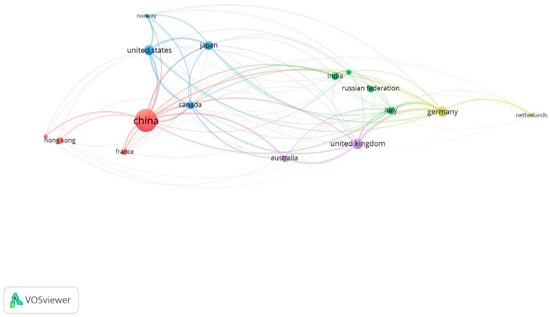
Figure 1.
BC of countries (line 174).
Another fascinating question is how authors from various nations have interconnected with authors from other countries. A co-authorship analysis with governments accomplishes this. The co-authorship pattern is depicted in Figure 2, in terms of nations performing green finance research. Recall that we can determine a country’s total number of publications and its critical ties with other nations through co-authorship.
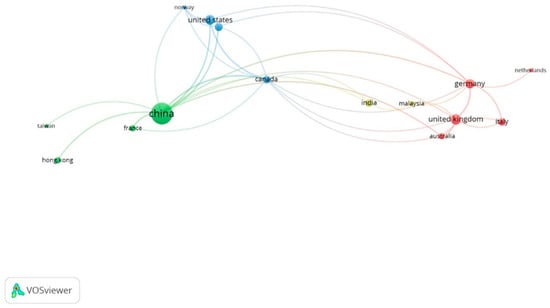
Figure 2.
Co-authorship among countries (line 189).
Figure 2 represents the networking of co-authorship with different colors. For example, China is the most productive country, with the strongest co-authorship with other countries, meaning that the authors from other countries collaborate with Chinese authors.
4.3. Universities and Institutes with the Most Significant Number of Publications
Another significant aspect of the bibliometric analysis is to see which institute or university is the most productive. The results in Table 3 show that Hong Kong Polytechnic University is the most productive university, publishing five papers. Jinan University and Keio University are ranked 2nd and 3rd, with five and four papers, respectively. In the case of a tie, the authors are rated based on the number of citations their documents received.

Table 3.
The most productive universities (line 196).
4.4. Top Journals in Terms of Productivity
Another essential part of the bibliometric analysis is to analyze the most productive journals, which publish more research on green finance than others. Table 4 illustrates the journals publishing the research on green finance. The results are based on a minimum of 10 publications. Sustainability is the top journal, with 11 journals, followed by the Journal of Sustainable Finance and Investment, with 8 publications between 2005 and 2020. The Journal of Cleaner Production, with one paper less than the 2nd place publication, ranks 3rd.

Table 4.
Top journals that publish green finance research (line 206).
The co-citation analysis of these top journals is an intriguing component of the bibliometric study. Co-citation happens when two papers from two distinct journals are cited jointly by a third document. For example, Figure 3 shows that the Energy Policy has the strongest co-citations amongst all of the journals, followed by the Journal of Cleaner Production and Sustainability. These facts show that the journals presented in Table 4 share similar literature, and that is why they have strong co-citations.
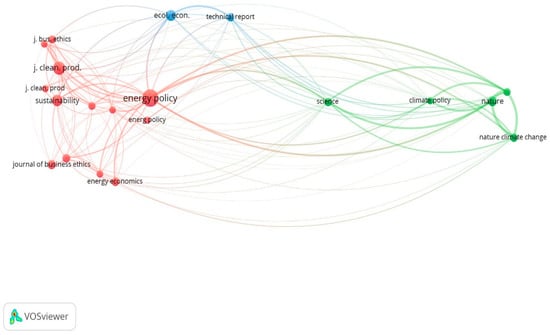
Figure 3.
Co-citation of the top journals (line 215).
4.5. The Most Prolific Authors in Green Finance
See Table 5 to view the results of those who publish most frequently on green finance. It shows Falcone P.M., Ng A.W., Taghizadeh-Hesary F., and Yoshino N., each with four publications.

Table 5.
The most productive authors in pro-environmental behavior (line 220).
4.6. The Most-Cited Publication
Another critical factor when it comes to evaluating the output of authors, journals, and papers is the most-cited source or reference. Therefore, we listed the most-cited publication in this section. We relied on the data from the Scopus database. As stated in the Method section, we searched “Green Finance” in the article’s title, abstract, keywords, and text. This process provided us with a list of all those publications with green finance and the related keywords mentioned above in their title, abstract, or keywords. Table 6 presents the list of publications that received more than 10 citations.

Table 6.
The most-cited publication (line 229).
4.7. Three-Field Plot
To determine the author’s area of specialization in green finance, we conducted a three-field plot analysis. This study establishes a link between authors and the keywords they included in their green finance papers. In Figure 4, the authors’ names are listed on the left, the keywords used in the green finance paper are listed in the middle, and the authors’ countries are shown on the right. We may easily deduce the author’s field of study from the direction of the links. For example, Liu C mainly used green finance, green economy, and sustainable development as keywords, so his research mainly concerns green economic problems in sustainable development from a financial perspective. Similarly, Ng A.W. mainly wrote on green finance, sustainability, and green bonds, which indicates his research was specific to green bond instruments.
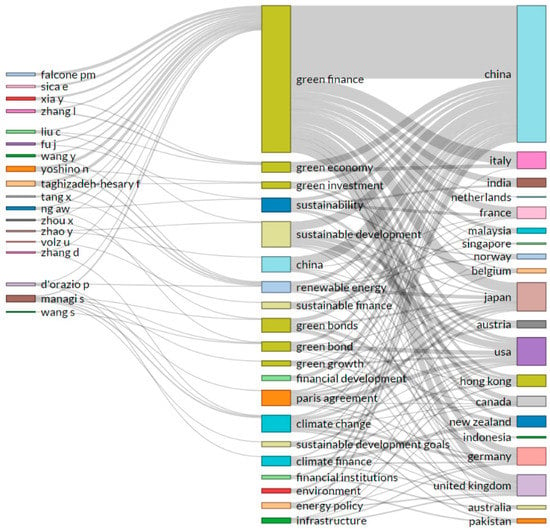
Figure 4.
Three-field plot representing authors’ area of research (line 242).
4.8. Co-Occurrence of Authors’ Keywords
This section analyses the content further, in terms of keywords, which is a valuable tool for locating relevant literature and trends. In this phase of the investigation, VOSviewer software is used to discuss the co-occurrence of the authors’ keywords to explain the features of publications in green finance, and the results are displayed in Figure 5. Note that the keywords analyzed here are based on the text content of keywords in papers. Also, the co-occurrence implies the frequency that a keyword appears with other keywords. In this research, keyword analyses are utilized to find trends in the subjects examined.

Figure 5.
Co-occurrence of authors’ keywords (line 250).
Current scholars can use keyword analysis to find unidentified themes and domains in the literature. Of course, it is impossible to anticipate which subjects will receive more attention in the future. Nevertheless, based on the co-occurrence of the terms, we believe that the current trend will continue.
4.9. The Thematic Map: A Co-Word Analysis
To draw a thematic map (Figure 6) of the keywords of green finance, we used the Biblioshiny package of RStudio, with a minimum frequency of five per thousand words. This technique helps to map the main themes of the journal. Based on the suggestion proposed by Cobo et al. [36], this strategic map plotted the main themes into four quadrants, according to their density and centrality ranks along the X and Y axes. Centrality is a measure of the interaction of a network with other networks, and it is the measure of the importance of theme in the whole research; in this case, green finance [36]. In comparison, density identifies the degree of development of themes based on the internal strengths of the network.
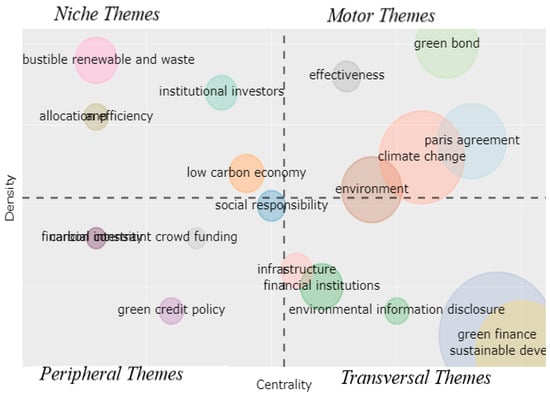
Figure 6.
Thematic map of the journal (line 294).
4.9.1. Motor Themes
These themes are well developed and constitute the critical structure of the research in the journal. Moreover, these themes share high centrality and density. This quadrant contains climate change, the Paris Agreement, effectiveness, green bond, and environment. These facts show that the journal’s major developed research areas are based on environmental and global climate issues, and green bond is the most advanced theme.
4.9.2. Niche Themes
Niche themes are very specialized and well-developed themes of a research area or journal. According to the results presented in Figure 6, the journal’s well-developed and specialized research areas are institutional investors, allocations efficiency, and low-carbon economy. The most used concept is bustible renewable and waste.
4.9.3. Peripheral Themes
The third quadrant consists of the themes that are either emerging or declining in the journal. These themes are characterized by low centrality and low density. This quadrant includes social responsibility, crowdfunding, green credit policy, financial industry, and carbon density (they overlap in the image). From the Figure 6, we can see that social responsibility is moving towards a higher centrality, which shows its more universal significance when compared with the rest of the quadrants in the journal.
4.9.4. Transversal Themes
The fourth quadrant is characterized as low density and high centrality. These themes are essential for the research, but are not well developed. Interestingly, specific themes, such as green finance and sustainable development, are further away from the motor themes and peripheral themes. These themes have a lower density, but higher centrality, than the other themes present in this quadrant.
5. Topic Trends and Some Future Research Suggestions
In addition to the keyword co-occurrence analysis, it is also of great interest to understand the popularity of different topics and themes during the past 15 years, from the time window. On the one hand, from Figure 7, we can see that during the early years of green finance publication (2005–2014), finance was the only area of research in the journal. On the other hand, from 2015 to 2018, research on corporate social responsibility, green growth, low-carbon economy, and sustainability, which studies environment protections from an economic perspective, has been in fashion. Until 2019, green finance, green bonds, and green investment became independent topics amongst researchers.
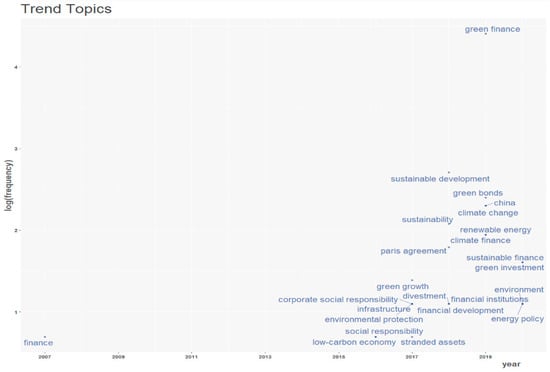
Figure 7.
Trends of the topic in the journal (line 317).
The thesis established in this paper had the bibliometric analysis of green finance as its core focus. That is a new debate, and there are still several possibilities for fresh research prospects, including the holes found in this report. Current environmental problems lead to tremendous pressure on businesses and the public sector to participate in regular debates, mainly on financial viability, which profoundly affects corporate behavior.
Since firms concentrate on growing their financial profits, sustainable activities in the corporate culture are necessary for them to be implemented. Therefore, a holistic vision of green finance is critical to tackling this issue. The thesis discusses this vital question in this context, adopting an objective bibliometric method and obtaining results from various dimensions.
This essay was designed to present the key topics in the area. Therefore, the holes can be considered as an incentive for future research, looking at the content presented in this discussion platform until 2020. The trends were obtained by the study. After reviewing it in association with previous results, we were able to see that a research agenda already remains. This needs to be further explored in new studies in economics, entrepreneurship, and sustainability. Its great value and fast-growing relevance have been demonstrated by green finance. With growing curiosity in the recent literature, but a lack of coverage from mainstream economics and finance journals, a void has been generated that offers researchers prospects for potential advances in at least three directions.
Firstly, given that green finance is fundamentally a finance topic, there is an immediate need to research the problems of green finance from the viewpoint of finance and the use of financial techniques. In conventional finance papers, green bonds, green risk management, and green governance may be of concern.
Secondly, further research from developed countries’ viewpoints on green finance issues will be beneficial for regulators and decision-makers to coordinate diverse policy priorities and develop well-defined policy targets. More resources will be offered to scholars from developing countries with specific knowledge advantages, and more international cooperation between developing and developed countries is expected.
Thirdly, it should be noted that a remarkable contrast between the problems of green finance and traditional finance is that the former is primarily guided by regulation.
Thus, with the increasingly evolving international economic and political climate, new problems in this area are expected to arise. In addition, to the best of our understanding, there is still no systematic analysis of relevant literature available. It is certainly worth investigating the findings of our bibliometric research and making comparisons.
6. Limitations
Despite this study’s contribution, it experiences some shortcomings. Firstly, the study is based on bibliometric data derived from the Scopus database, but the shortcomings of this database also weaken the universality of the study. In addition, there might be several papers and journals that are indexed in the Web of Sciences, but are not indexed in the Scopus. Those are exempt from this study. We also recommend that future research extracts information from other databases, such as the Science Site and the host, EBSCO. Secondly, the research performed a retrospective review from 2005 to 2020, in terms of visual analysis. Therefore, we recommend that future studies complete some temporal analyses to see how patterns in green finance literature grow over different years.
Author Contributions
Conceptualization, R.C.; methodology, R.C.; validation, J.G.; formal analysis, R.C.; investigation, R.C.; resources, R.C.; data curation, R.C.; writing—original draft preparation, R.C.; writing—review and editing, J.G.; visualization, R.C.; supervision, J.G.; project administration, J.G.; funding acquisition, J.G. All authors have read and agreed to the published version of the manuscript.
Funding
This research was funded by humanities and social science research, and the Planning Foundation of the Ministry of Education of China, grant number 19YJA630022, and The APC was funded by Beijing Natural Science Foundation Project, grant number 9192002.
Data Availability Statement
All data involved in this study were obtained from the Scopus database.
Conflicts of Interest
The authors declare no conflict of interest.
References
- Wang, S.; Wang, J.; Li, J.; Yang, F. Do motivations contribute to local residents’ engagement in pro-environmental behaviors? Resident-destination relationship and pro-environmental climate perspective. J. Sustain. Tour. 2020, 28, 834–852. [Google Scholar] [CrossRef]
- Ansari, N.; Farrukh, M.; Raza, A. Green human resource management and employees pro-environmental behaviours: Examining the underlying mechanism. Corp. Soc. Responsib. Environ. Manag. 2020, 28, 229–238. [Google Scholar] [CrossRef]
- Whitburn, J.; Linklater, W.; Abrahamse, W. Meta-analysis of human connection to nature and proenvironmental behavior. Conserv. Biol. 2020, 34, 180–193. [Google Scholar] [CrossRef]
- Ture, R.S.; Ganesh, M.P. Pro-environmental behaviours at workplace: An empirical study in Indian manufacturing organizations. Benchmarking Int. J. 2018, 25, 3743–3766. [Google Scholar] [CrossRef]
- Raza, A.; Farrukh, M.; Iqbal, M.K.; Farhan, M.; Wu, Y. Corporate social responsibility and employees’ voluntary pro-environmental behavior: The role of organizational pride and employee engagement. Corp. Soc. Responsib. Environ. Manag. 2021. [Google Scholar] [CrossRef]
- Yong, J.Y.; Yusliza, M.Y.; Fawehinmi, O.O. Green human resource management: A systematic literature review from 2007 to 2019. Benchmarking Int. J. 2019, 27, 2005–2027. [Google Scholar] [CrossRef]
- Clement, C.; Lochan, D.R. Green competencies: Insights and recommendations from a systematic literature review. Benchmarking Int. J. 2020. [Google Scholar] [CrossRef]
- Li, D.; Zhao, L.; Ma, S.; Shao, S.; Zhang, L. What influences an individual’s pro-environmental behavior? A literature review. Resour. Conserv. Recycl. 2019, 146, 28–34. [Google Scholar] [CrossRef]
- Inoue, Y.; Alfaro-Barrantes, P. Pro-environmental behavior in the workplace: A review of empirical studies and directions for future research. Bus. Soc. Rev. 2015, 120, 137–160. [Google Scholar] [CrossRef] [Green Version]
- Farrukh, M.; Raza, A.; Meng, F.; Wu, Y. CMS AT 13: A retrospective of the journey. Chin. Manag. Stud. 2020, 1–29. [Google Scholar] [CrossRef]
- Gu, Z.; Meng, F.; Farrukh, M. Mapping the research on knowledge transfer: A scientometrics approach. IEEE Access 2021, 9, 34647–34659. [Google Scholar] [CrossRef]
- Gao, P.; Meng, F.; Mata, M.N.; Martins, J.M.; Iqbal, S.; Correia, A.B.; Dantas, R.M.; Waheed, A.; Rita, J.X.; Farrukh, M. Trends and future research in electronic marketing: A bibliometric analysis of twenty years. J. Theor. Appl. Electron. Commer. Res. 2021, 16, 94. [Google Scholar] [CrossRef]
- Nawaz, K.; Saeed, H.A.; Sajeel, T.A. Covid-19 and the state of research from the perspective of psychology. Int. J. Bus. Psychol. 2020, 2, 35–44. [Google Scholar]
- Farrukh, M.; Raza, A.; Javed, S.; Lee, J.W.C. Twenty years of green innovation research: Trends and way forward. World J. Entrep. Manag. Sustain. Dev. 2021. [Google Scholar] [CrossRef]
- Ahmed, S.I.; Farrukh, M.; Yihua, W.; Trunk, N. Human systems management: A retrospective of 40 years. Hum. Syst. Manag. 2021, 41, 15–30. [Google Scholar]
- Nawaz, K.; Aslam, T.; Saeed, H.A. A bibliometric analysis of international journal of sports marketing & sponsorship. Int. J. Bus. Psychol. 2020, 2, 45–60. [Google Scholar]
- Labatt, S.; White, R.R. Environmental Finance: A Guide to Environmental Risk Assessment and Financial Products; John Wiley & Sons: New York, NY, USA, 2003. [Google Scholar]
- Hira, T.K. Promoting sustainable financial behaviour: Implications for education and research. Int. J. Consum. Stud. 2012, 36, 502–507. [Google Scholar] [CrossRef]
- Berensmann, K.; Volz, U.; Alloisio, I.; Bak, C.; Bhattacharya, A.; Leipold, G.; Schindler, H.; MacDonald, L.; Huifang, T.; Yang, Q. Fostering Sustainable Global Growth through Green Finance—What Role for the G20. T20 Task Force Clim. Policy Financ. 2017. Available online: https://collaboration.worldbank.org/content/usergenerated/asi/cloud/attachments/sites/collaboration-for-development/en/groups/green-finance-community-of-practice/documents/jcr:content/content/primary/blog/green_finance_educat-LVNC/Climate_Green-Finance_V2.pdf (accessed on 8 June 2021).
- Jeucken, M. Sustainable Finance and Banking: The Financial Sector and The Future of The Planet; Earthscan: London, UK, 2010. [Google Scholar]
- European Banking Federation. Towards A Green Finance Framework; Brussels, Belgium; Frankfurt, Germany, 2017; Available online: https://www.ebf.eu/wp-content/uploads/2017/09/Geen-finance-complete.pdf (accessed on 8 June 2021).
- Bergset, L. The rationality and irrationality of financing green start-ups. Adm. Sci. 2015, 5, 260–285. [Google Scholar] [CrossRef] [Green Version]
- Farrukh, M.; Meng, F.; Wu, Y.; Nawaz, K. Twenty-eight years of business strategy and the environment research: A bibliometric analysis. Bus. Strateg. Environ. 2020, 29, 2572–2582. [Google Scholar] [CrossRef]
- Farrukh, M.; Shahzad, I.A.; Meng, F.; Wu, Y.; Raza, A. Three decades of research in the technology analysis & strategic management: A bibliometrics analysis. Technol. Anal. Strateg. Manag. 2020, 1–17. [Google Scholar] [CrossRef]
- Wu, Y.; Farrukh, M.; Raza, A.; Meng, F.; Alam, I. Framing the evolution of the corporate social responsibility and environmental management journal. Corp. Soc. Responsib. Environ. Manag. 2021. [Google Scholar] [CrossRef]
- Rose, R.; Hölzle, K.; Björk, J. More than a quarter century of creativity and innovation management: The journal’s characteristics, evolution, and a look ahead. Create. Innov. Manag. 2020, 29, 5–20. [Google Scholar] [CrossRef] [Green Version]
- Farrukh, M.; Meng, F.; Raza, A. Twenty-seven years of sustainable development journal: A bibliometric analysis. Sustain. Dev. 2020, 28, 1725–1737. [Google Scholar] [CrossRef]
- Bonilla, C.A.; Merigó, J.M.; Torres-Abad, C. Economics in Latin America: A bibliometric analysis. Scientometrics 2015, 105, 1239–1252. [Google Scholar] [CrossRef]
- Martínez-López, F.J.; Merigó, J.M.; Valenzuela-Fernández, L.; Nicolás, C. Fifty years of the European journal of marketing: A bibliometric analysis. Eur. J. Mark. 2018, 52, 439–468. [Google Scholar] [CrossRef]
- Laengle, S.; Merigó, J.M.; Miranda, J.; Słowiński, R.; Bomze, I.; Borgonovo, E.; Dyson, R.G.; Oliveira, J.F.; Teunter, R. Forty years of the European journal of operational research: A bibliometric overview. Eur. J. Oper. Res. 2017, 262, 803–816. [Google Scholar] [CrossRef] [Green Version]
- Garrigos-Simon, F.J.; Botella-Carrubi, M.D.; Gonzalez-Cruz, T.F. Social capital, human capital, and sustainability: A bibliometric and visualization analysis. Sustainability 2018, 10, 4751. [Google Scholar] [CrossRef] [Green Version]
- Amiguet, L.; Lafuente, A.M.; Kydland, F.E.; Lindahl, J.M.M. One hundred and twenty-five years of the journal of political economy: A bibliometric overview. J. Polit. Econ. 2017, 125, 105–110. [Google Scholar]
- Van Eck, N.; Waltman, L. Software survey: VOSviewer, a computer program for bibliometric mapping. Scientometrics 2010, 84, 523–538. [Google Scholar] [CrossRef] [Green Version]
- Small, H. Co-citation in the scientific literature: A new measure of the relationship between two documents. J. Am. Soc. Inf. Sci. 1973, 24, 265–269. [Google Scholar] [CrossRef]
- Baraibar-diez, E.; Luna, M.; Odriozola, D.; Llorente, I. Mapping social impact: A bibliometric analysis. Sustainability 2020, 12, 9389. [Google Scholar] [CrossRef]
- Cobo, M.J.; López-Herrera, A.G.; Herrera-Viedma, E.; Herrera, F. An approach for detecting, quantifying, and visualizing the evolution of a research field: A practical application to the fuzzy sets theory field. J. Informetr. 2011, 5, 146–166. [Google Scholar] [CrossRef]
Publisher’s Note: MDPI stays neutral with regard to jurisdictional claims in published maps and institutional affiliations. |
© 2021 by the authors. Licensee MDPI, Basel, Switzerland. This article is an open access article distributed under the terms and conditions of the Creative Commons Attribution (CC BY) license (https://creativecommons.org/licenses/by/4.0/).